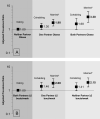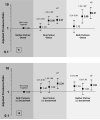Entry into romantic partnership is associated with obesity
- PMID: 19360012
- PMCID: PMC2745942
- DOI: 10.1038/oby.2009.97
Entry into romantic partnership is associated with obesity
Abstract
BMI is highly correlated between spouses; however, less is understood about the underlying mechanism(s) by which the development of obesity in one individual increases the risk of obesity in his/her spouse. The objective of this study is to investigate whether romantic partnership and duration of cohabitation are related to incident obesity and obesity-promoting behaviors. We used two data sets from the National Longitudinal Study of Adolescent Health: (i) 6,949 US adolescents (wave II, 1996) followed into adulthood (wave III, 2001-2002) and (ii) 1,293 dating, cohabiting, and married romantic couples from wave III, including measured anthropometry and self-report behavior data. In the longitudinal cohort, we used sex-stratified logistic regression models to examine the risk of incident obesity by longitudinal romantic relationship status and duration of time spent living with a romantic partner. In the Couples Sample, we used multinomial logistic regression to predict concordance in outcomes: obesity, moderate-to-vigorous physical activity, and screen time by romantic partnership and duration of time living with a romantic partner. Individuals who transitioned from single/dating to cohabiting or married were more likely to become obese than those who were dating at both waves. Partner concordance for negative, obesity-related behaviors was strongest for married couples and couples who lived together > or =2 years. The shared household environment may increase the likelihood of becoming obese, influence partner concordance, and may be an important target for obesity intervention.
Figures




Similar articles
-
Spousal cardiometabolic risk factors and incidence of type 2 diabetes: a prospective analysis from the English Longitudinal Study of Ageing.Diabetologia. 2018 Jul;61(7):1572-1580. doi: 10.1007/s00125-018-4587-1. Epub 2018 Mar 8. Diabetologia. 2018. PMID: 29520580
-
Disrupting intergenerational continuity in harsh and abusive parenting: the importance of a nurturing relationship with a romantic partner.J Adolesc Health. 2013 Oct;53(4 Suppl):S11-7. doi: 10.1016/j.jadohealth.2013.03.014. J Adolesc Health. 2013. PMID: 24059934 Free PMC article.
-
Changes in Body Mass Index and Obesity Risk in Married Couples Over 25 Years: The ARIC Cohort Study.Am J Epidemiol. 2016 Mar 1;183(5):435-43. doi: 10.1093/aje/kwv112. Epub 2015 Sep 23. Am J Epidemiol. 2016. PMID: 26405117 Free PMC article.
-
Association of Preterm Birth and Low Birth Weight With Romantic Partnership, Sexual Intercourse, and Parenthood in Adulthood: A Systematic Review and Meta-analysis.JAMA Netw Open. 2019 Jul 3;2(7):e196961. doi: 10.1001/jamanetworkopen.2019.6961. JAMA Netw Open. 2019. PMID: 31298716 Free PMC article.
-
Folic acid supplementation and malaria susceptibility and severity among people taking antifolate antimalarial drugs in endemic areas.Cochrane Database Syst Rev. 2022 Feb 1;2(2022):CD014217. doi: 10.1002/14651858.CD014217. Cochrane Database Syst Rev. 2022. PMID: 36321557 Free PMC article.
Cited by
-
Diet, physical activity and socio-economic disparities of obesity in Lebanese adults: findings from a national study.BMC Public Health. 2015 Mar 21;15:279. doi: 10.1186/s12889-015-1605-9. BMC Public Health. 2015. PMID: 25880751 Free PMC article.
-
Socioeconomic and Demographic Factors for Spousal Resemblance in Obesity Status in China.Healthcare (Basel). 2020 Oct 21;8(4):415. doi: 10.3390/healthcare8040415. Healthcare (Basel). 2020. PMID: 33096592 Free PMC article.
-
Couple BMI trajectory patterns during mid-later years: Socioeconomic stratification and later-life physical health outcomes.J Fam Psychol. 2020 Aug;34(5):630-641. doi: 10.1037/fam0000644. Epub 2020 Feb 27. J Fam Psychol. 2020. PMID: 32105098 Free PMC article.
-
Project TEAMS (Talking about Eating, Activity, and Mutual Support): a randomized controlled trial of a theory-based weight loss program for couples.BMC Public Health. 2017 Sep 29;17(1):749. doi: 10.1186/s12889-017-4732-7. BMC Public Health. 2017. PMID: 28962602 Free PMC article. Clinical Trial.
-
Marriage contributes to higher obesity risk in China: findings from the China Health and Nutrition Survey.Ann Transl Med. 2021 Apr;9(7):564. doi: 10.21037/atm-20-4550. Ann Transl Med. 2021. PMID: 33987262 Free PMC article.
References
-
- Lund R, Due P, Modvig J, Holstein BE, Damsgaard MT, Andersen PK. Cohabitation and marital status as predictors of mortality--an eight year follow-up study. Soc Sci Med. 2002;55:673–9. - PubMed
-
- Duncan GJ, Wilkerson B, England P. Cleaning up their act: the effects of marriage and cohabitation on licit and illicit drug use. Demography. 2006;43:691–710. - PubMed
-
- Umberson D. Gender, marital status and the social control of health behavior. Soc Sci Med. 1992;34:907–17. - PubMed
-
- Kahn HS, Williamson DF. The contributions of income, education and changing marital status to weight change among US men. Int J Obes. 1990;14:1057–68. - PubMed
-
- Rissanen AM, Heliovaara M, Knekt P, Reunanen A, Aromaa A. Determinants of weight gain and overweight in adult Finns. Eur J Clin Nutr. 1991;45:419–30. - PubMed
Publication types
MeSH terms
Grants and funding
LinkOut - more resources
Full Text Sources
Medical

